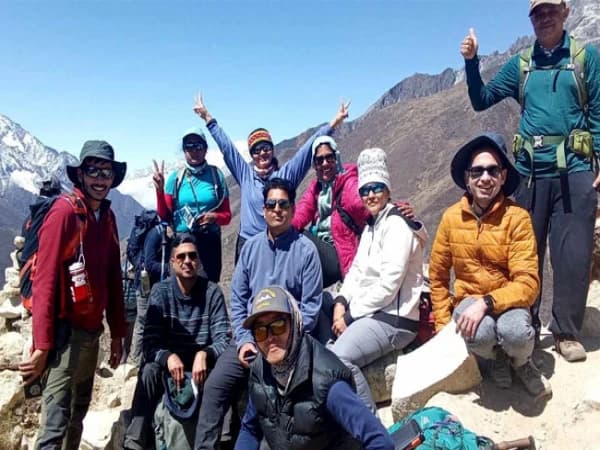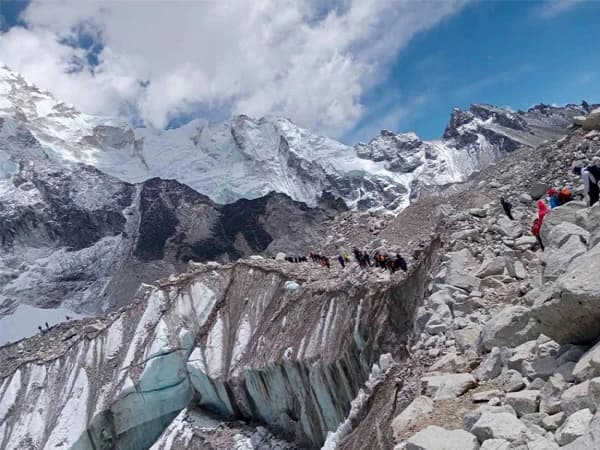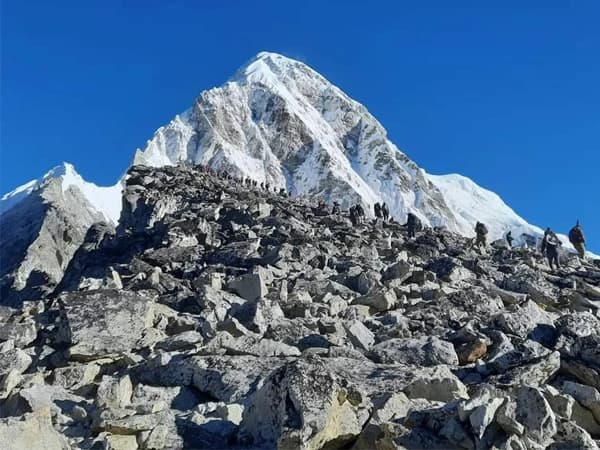This 20-day Everest Three High Passes Trek by road follows the ancient trailhead, starting with a jeep drive to Salleri from Kathmandu, avoiding the hassle of the Lukla Flight, and covers the ancient trailhead at the same time.
If you are looking forward to exploring the rich Sherpa villages, cultures, and traditions passing through the off-beaten trailhead, and covering major iconic destinations, including the six series of Gokyo lakes, three pinnacles of Everest: Kongma La Pass, Renjo La Pass, EBC, KalaPatthar, with a deep exploration of the iconic Everest region, at the same time, you want to avoid the frustations of delay of flight to Lukla, that ruins your scehdules, then, this package fits perfectly for you.
Everest Three High Passes Trek by Road Overview
The Everest region in Nepal, where the world's highest peak, Mount Everest, along with other iconic Himalayan peaks, is surely one of the bucket list adventures that every explorer seeks to walk through. Usually, this trip starts with a thrilling flight to Lukla, followed by the regular standard itinerary, whereas the overland route to Salleri (2392 meters), which lets you explore the scenic pathway, and get an insight into the locals that reside in the lower Solukhumbu district, with distinct ethnic groups such as Sherpa, Rai, Limbu, Gurung that has been residing here since 90's, as settling at the first two days, at Salleri, Paiya Thamdanda before touching the regular route from Phakding via Lukla.
This Everest Three High Passes trek by road is one of the most thrilling and loved adventures by adventure enthusiasts across the globe, which explores the iconic Sagarmatha National Park, witnessing the marvelous transitions of the forest, landscapes, alpine valleys, highly towering mountains, pristine wetlands, and achieving the Everest Three pinnacles at the same time, and the top of the Kala Patthar at 5545 meters as well. Even though the Everest Three High Passes Trek might seem like a long duration and challenging, which demands a strong physical stamina, resilience, and a hawk-like spirit, it is safe to undertake, as the itinerary is well customized with 3 major acclimatization days in between, at Namche Bazaar, Gokyo village, and Chhukung, before proceeding to higher altitudes.
The first half of the trekking route covers the lower elevation below 4000 meters, which starts with a roadway drive towards Salleri from Kathmandu (1360 m), and Paiya Thamdanda, the other day, which marks be starting point of the walking trail. Then, joining the regular route to Everest Base Camp (EBC), from Phakding (2642 m), the journey continues towards Namche (3440 m), Tengboche Monastery (3860 m), and ascends higher to Dingboche (4410 m) and Chhukung (4732 m), from where we will make our 1st crossing of the high passes, which is Kongma La Pass at 5540 meters.
Descending from the top of the pass, towards Lobuche and then Gorakshep (5184 m), the other day, the side visit from here leads you to the iconic Everest Base Camp at 5364 meters, with the jaw-dropping views of sparkling Khumbu glacier, and the panorama of the Lhotse and Nuptse, with Khumbu Ice Fall. The next morning stands out to be one of the best highlights of this trip, as we will take a morning ascent to the huge black rock, of Kala Patthar at 5545 meters, for the breathtaking sunrise view over the almighty Mt. Everest, with other surrounding peaks, marking it as a memorable moment of the trip. Persisting the hike, towards Dzong La, and another high pass crossing over at 5367 meters, of Cho La Pass, the route then touches the Gokyo route, after descending to Thagnak.
Exploring the famous Gokyo Valley, the vantage point of Gokyo Ri, and the series of six Gokyo Lakes, and through full-on beaten adventure, and ancient Sherpa lifestyle, as we pass through several settlements such as Thame, Marulung, Thaknak, etc, we will cross the last high pass, which stands out to be Renjo La Pass (5360 meters), the route then, rejoins the regular EBC route at Namche Bazaar. Descending to the lower Khumbu region further, at Chauri Kharka and Paiya Thamdanda on the following two days, we will conclude our trek with a jeep drive back to Kathmandu.
Throughout the journey, you will be accompanied by several Himalayan peaks such as Ama Dablam, Cholatshe, Tharmseku, Makalu, Cho Oyu, Nuptse, Lhotse, and the fish lens view of the almighty Everest itself. As this route circulates almost every corner of the Everest region, the overview of the mountains remains through distinct angles and perspectives, with a navigation through off-beaten and less crowded trails, where you get to immerse in the serene beauty of the highlands.
Note: As this trek goes all the way via roadway, avoiding the Lukla flight, whereas, if you are short in time, then, you can consider the regular Three Passes Trek, that ends within 19 days. On the other hand, you can experience both ways, by starting the trip with overland route, to Salleri, and ending the journey with a flight from Lukla, either way, the itinerary can be customized as per your choice and budget.
Highlights of the Everest Three High Passes Road Trek
- Overland jeep drive from Kathmandu to Salleri, entering the Solukhumbu district, encountering ancient Sherpa villages and other distinct ethnic groups, such as Rai and Limbu
- Witness the marvelous transition of the climatic zones, from the lower altitude of the blooming red rhododendron and pine forest, and rugged rocky high cliff landscapes, to the alpine valley with snow-capped peaks
- Arrive at the lap of the world's highest peak at 5367 meters, at Everest Base Camp
- Get 3 acclimatization days, in between, including several side trips, which explore some of the great vantage points and help in safe ascent
- Undertake the off-beaten trailhead, within the iconic Khumbu region, passing through the less crowded route, feeling serenity
- Explore the holy Gokyo Lake, with the other five series of these lakes, along the largest Himalayan glacier, Ngozumpa
- Unravel the astonishing three pinnacles over 5000 meters, feeling a sense of thrill and accomplishment
- Unveil one of the notable settlements of Gokyo valley, and reach the Gokyo Ri viewpoint as well, flanked by colorful prayer flags
- Surround yourself with the panoramic insight of the sunrise view over Mount Everest, from the highest point at Kala Patthar (5545 m).
Why do the Everest Three High Passes Trek without the Lukla Flight?
This Everest Three High Passes Road Trek for 20 days is significantly different than the regular route that starts with a Lukla Flight, in fact, it explores more of the Everest region and the lower Solukhumbu district as well. The main motive for crafting this package for you is surely to avoid the thrilling flight to Lukla, and undertake the journey via jeep ride; however, there are some major advantages/ perks that make this trip truly fascinating and worth it, ensuring safety and budget-friendly at the same time.
Safe Ascend with Proper Acclimatization
As this journey starts from Salleri with an altitude of 2390 meters, which ascends slowly, adopting the rising high altitude, where your body already gets used to the thinning air, it is an intelligent way to acclimatize and avoid the high possibility of altitude sickness. Rather than starting the walking trail soon after reaching Lukla (2860 meters) toward Phakding, the hike begins at a lower altitude, with a navigation of 2-day trek within the lower Khumbu region; hence, by far, you get to the higher elevation, for instance, over 3000 meters at Namche Bazaar, your body gets accustomed to the low oxygen, ensuring safe ascend.
Avoid the hectic, anxious, and delayed Lukla Flight
During the peak or at any time of the year, the possibility of delay of the Lukla Flight remains high, due to traffic congestion and climate fluctuations, which, comprehensively, lengthen your trip to more days, and can even cancel your international flight as well. The main motive of this trekking itinerary is to mitigate the possibility of delaying the overall trip.
Also, for a more comforting Himalaya adventure, the transportation means that is provided during the trip, to reach the walking trail - Thamdanda, is a private 4WD jeep, which is the best way to begin the odyssey with, as you do not want to surely start the venture, with a mental stress, and watching over ticking clock, to finally proceed. Hence, the overland jeep ride to the three high passes allows you to plan, schedule the trip, and get prepared accordingly, without any doubts.
Unique Route Covering the Classic Famous Trailhead
While many of the individuals might perceive that this Everest Three High Passes Overland Trek for 20 days is totally different, the route covers the same route as the standard itinerary does, which begins with a flight to Lukla. The only difference, and the best major attraction, as well, marks to be the shorter days of exploration of the ancient Solukhumbu district, which used to be the regular route, before the Lukla Flight was built; hence, you get past the lower Khumbu region and follow the footprints of legendary summiters and hikers, passing via Salleri, Thamdanda, Paiya, Chauri Kharka, and many others.
At the same time, the famous settlements as well including Phakding, proceed towards Lukla, a bustling town of Namche Bazaar, Tengboche, Dingboche, and the 3 passes of Cho La, Renjo La, and Kongma La, with a series of six lakes, Gokyo Ri, and EBC (Everest Base Camp).
Experience the Off-the-Beaten-Path Adventure Immersed in Ancient Sherpa Culture
The major highlighted section of this Himalayan adventure is surely the exploration of the Sherpa locals, lifestyles, and ancient culture, not being influenced by the world. As the journey leads to several settlements covering the wild off-beaten serene terrains, via Thame, Chhukung, Dzongla, Marulung, and many others, with the ancient tea house, showing the untamed culture of the sherpas, along with rai, tamang, and gurung as well, where you get to gain insight into how locals run their livelihood, with hosting lodges, agricultural workings, and animal husbandry.
On the other hand, you will cover more of a less crowded trailhead, and varied terrains such as rugged rocky sections, and navigation through the woodlands of the blooming red rhododendrons, pines, with an insight into the Himalayan rare species and birds as well, and also offers a thrill of climbing the Everest pinnacles via icy trails, presenting a sense of accomplishment.
Everest Three High Passes Trek by Road Cost for 2025 and 2026
The trek to Everest Three High Passes by road without Lukla Flight cost depends highly on how your itinerary has been set, the route that you will undertake, the vehicle you are opting for, and most importantly, the kind of packages that you have chosen, as there are semi-luxury options as well. Meanwhile, our trekking package via jeep ride costs start from USD 1199 and go up to USD 1599 per head, which highly depends on the number of people that your group basically holds, whereas, if you are alone, and looking for a private, elusive solo trip, then the standard price stands out to be USD 1599 exclusively.
Our 20-day Everest Three High Passes Road Trek package covers every requirement for the trip with basic amenities such as standard meals, lodges, private jeep transportation, trekking permits, to an experienced local trekking guide, with other additional complements as well. To know what's included and excluded, you can check our cost details section. Here is a cost mentioned below, based on the number of pax that your group holds, especially customized for 2025 and 2026:
| No. of Pax | Standard Price (In USD) |
| 1-1 | 1599 per person |
| 2-2 | 1349 per person |
| 3-6 | 1249 per person |
| 7-10 | 1199 per person |
Additional Benefits of Booking with Destination Himalaya Treks
- 2 nights at a standard hotel before and after the trip (2 nights at Thamel) - the bustling tourism city
- Pre-Briefing Meeting, before you book your trip, by explaining the trek details in depth
- Customization of the trip, as per your budget and itinerary, guided by the pro expert teams
- Free Airport Shuttle - Airport pick-up and drop-off via private vehicle
- Private exclusive tour with an experienced local guide with an experience 10+ years of experience
- First Aid Kits with medicines (like Diamox, bandages, Sianex, and so on), and an oximeter - to check your pulse rate
- Sleeping Bag - must be returned after the trip is completed with us
- Additional gear like a Trekking T-shirt and a Cap
- 5% special discount to the family group (must be over 4)
- Farewell Dinner with a Trip Completion Certificate






